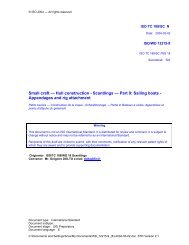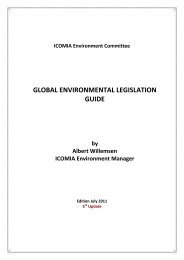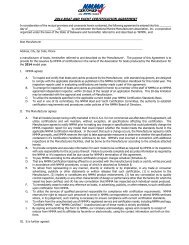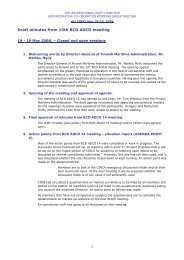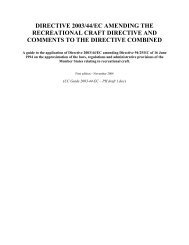Boat Transporters - National Marine Manufacturers Association
Boat Transporters - National Marine Manufacturers Association
Boat Transporters - National Marine Manufacturers Association
Create successful ePaper yourself
Turn your PDF publications into a flip-book with our unique Google optimized e-Paper software.
2.5 Hours of ServiceThe carrier will operate within the law including hours of service. Several laws apply to commercialmotor vehicle carriers. If a manufacturer knowingly loads a carrier’s equipment in an illegal manner or ifthe carrier is involved in an accident, the manufacturer will likely be drawn into a lawsuit or enforcementaction. Drivers operating a commercial motor vehicle are governed by the Federal Motor Carrier SafetyRegulations as to how many hours they are allowed to drive. Any carrier should agree that they willoperate within these limits. More information on the hours of service can be found at:http://www.fmcsa.dot.gov/rules-regulations/topics/hos/hos-2005.htm.2.6 Insurance RequirementsThe carrier will have all necessary insurance.Workers compensation: insurance coverage for an employee's work related accident or injury for medical costsand indemnity costs as prescribed by state law. This coverage is important for a carrier to provide for a potentialaccident or injury that may occur while the carrier’s employees are working on behalf of the manufacturer or at themanufacturer’s location. Keep in mind that if the drivers are contract employees, the carrier may not have workerscompensation. In that case, a transportation manager would need to know how the contract employees are coveredfor such an injury, if at all. It is recommended that the main contract identify this obligation and that it is the carrier’sresponsibility to provide this coverage.Automobile liability: insurance coverage that protects the carrier against financial loss because of legalliability for automobile-related injuries to others or damage to their property by an auto. This is essentialfor carriers as it provides coverage in the event that an accident occurs in the course of a freight delivery.A transportation manager will want the carrier to be adequately protected and have the policy extendadditional insured status to the manager’s company should the company be named in a claim or lawsuitby any third party that may be involved in the accident. Additional insured language is used whenadding a party to a liability policy.Motor truck cargo: insurance for the loss of property in the course of transit. This coverage is importantfor the insured value of the load that the carrier will be carrying for the boat manufacturer. The valuerequested should be enough to pay replacement cost for what the carrier is hauling for the boatmanufacturer. It is important that the term 'loss payee' is used when adding the boat manufacturerto this particular insurance. Loss payee is used when property is being insured.Commercial General Liability: insurance for the carrier's business organization for liability claims forbodily injury or property damage arising out of the carrier's premises, operations, products, and completedoperations, advertising and personal injury liability. The transportation manager will want the carrier tobe adequately protected and have the policy extend additional insured status to the boat manufacturer’scompany should it be named in a claim or lawsuit arising out of the carrier's business activities.Typically, insurance clauses in a contract are listed after the indemnification paragraph. They are meantto support the indemnification language, although not all items mentioned in an indemnification can beinsured. The reason for asking to be named as an additional insured on auto liability and general liabilitypolicies are generally so that the transfer of risk outlined in the contract or agreement will allow theboat manufacturer to be protected and defended under the carrier's insurance policy(ies). It may alsoavoid having losses impact the loss history of the additional insured, thus avoiding increased insurancepremiums in future years. And, it may increase the chances of cooperation between the parties in theevent of a claim or suit. It is important to name the correct legal entities that need to be named asadditional insured, which may include a parent company, subsidiaries, or affiliates.Requesting that a policy be non-contributory to any insurance that you carry is important so that aboat manufacturer’s insurance policies would not be brought into a claim or suit and the carrier’sinsurance would be primary. Should a claim or suit exhaust their insurance limits, the boat manufacturer’sinsurance would then be excess.Requesting notification of policy cancellation is important so that the transportation manager can beaware if a carrier loses his insurance by cancellation. Note that most insurance companies have a tenday notice for non-payment of premium, so cancellation notices should be reviewed immediately uponreceipt should it impact a particular relationship or load already scheduled.Requesting a defined financial rating of an insurance carrier is important so the transportation managerwill know that the carrier is placing their coverage with a financially sound insurance company, and ithas the reserves available to pay claims.A transportation manager should also review the deductibles when looking at a carrier’s insurance coverage.An evaluation of the carrier’s ability to meet the deductibles should be performed in the event of a claim.2.7 SCAC CodeDoes the carrier have a SCAC code? The Standard Carrier Alpha Code (SCAC) is a unique two-to-four-lettercode used to identify transportation companies. The <strong>National</strong> Motor Freight Traffic <strong>Association</strong> (NMFTA)developed the SCAC identification codes in the mid 1960s to facilitate computerization in the transportationindustry. The Standard Carrier Alpha Code is the recognized transportation company identification codeused in the American <strong>National</strong> Standards Institute (ANSI) Accredited Standards Committee (ASC) X12 andUnited Nations EDIFACT approved electronic data interchange (EDI) transaction sets such as the 856Advance Ship Notice, the 850 Purchase Order and all motor, rail and water carrier transactions wherecarrier identification is required. The SCAC is required on tariffs filed with the Surface TransportationBoard (STB). The United States Bureau of Customs and Border Protection has mandated the use of theSCAC for their Automated Manifest (AMS) and Pre-Arrival Processing (PAPS) Systems. SCACs arerequired when doing business with all U.S. Government agencies and with many commercial shippersincluding, but not limited to, those in the automobile, petroleum, forest products, and chemical industriesas well as suppliers to retail businesses and carriers engaged in railroad piggyback trailer and oceancontainer drayage. A Google search on “SCAC” will provide many sources for obtaining a SCAC code.2.8 OtherPrior to transport make sure fuel is drained from any fuel tanks. Often, warranty return boats orboats that have been used will have fuel in the fuel tanks. In order to avoid spills and damage, dealersand carriers should be instructed to drain all fuel out of boats before transporting.67



